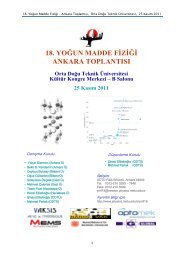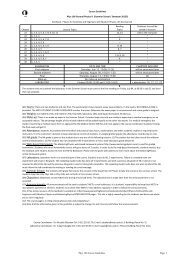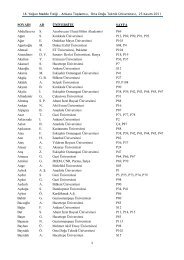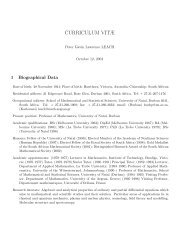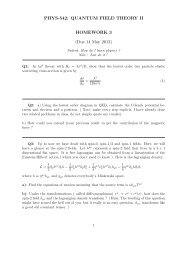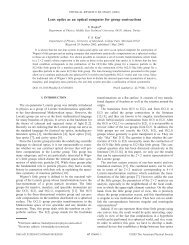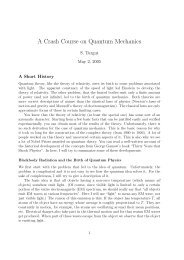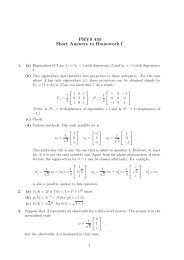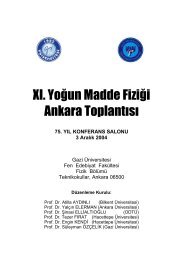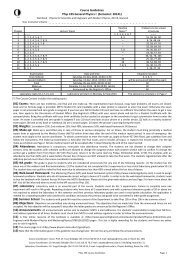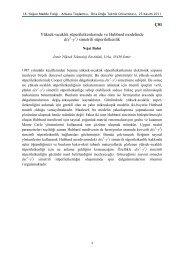166.2 Filtering6.2.1 ConvolutionDetectability is generally limited at the faintest flux levels by a background noise. The powerspectrumof the noise and that of the superimposed signal can be significantly different. Somegain in the ability to detect sources may therefore be obtained simply through appropriate linearfiltering of the data, prior to segmentation. In low density fields, an optimal convolution kernelh (“matched filter”) can be found that maximizes detectability. An estimator of detectability isfor instance the signal-to-noise ratio at source position (x 0 , y 0 ) ≡ (0, 0):( SN) 2≡ ((s ∗ h)(x 0, y 0 )) 2(n ∗ h) 2 , (3)where s is the signal to be detected, n the noise, and ‘∗’ the convolution operator. Moving toFourier space, we get:( SN) 2= (∫ SH dω) 2∫ |N | 2 |H| 2 dω , (4)where S and H are the Fourier-transforms of s and h, respectively, and |N | 2 is the powerspectrumof the noise. Remarking, using Schwartz inequality, thatwe see that∫∣ ∣2SH dω∣ ≤∫ |S|2|N | 2 dω ∫Equality (maximum S/N) in (5) and (6) is achieved for|N | 2 |H| 2 dω , (5)( ) S 2 ∫ |S|2≤ dω . (6)N |N | 2S|N | ∝ |N |H∗ , that is (7)H ∝S∗|N | 2 . (8)In the case of white noise (a valid approximation for many astronomical images, especially CCDones), |N | 2 = cste ; the optimal convolution kernel for detecting stars is then the PSF flippedover the x and y directions. It may also be described as the cross-correlation with the templateof the sources to be detected (for more details see, e.g. Bijaoui & Dantel 1970, or Das 1991).There are of course a few problems with this method. First of all, many sources of unquestionableinterest, like galaxies, appear in a variety of shapes and scales on astronomical images. Aperfectly optimized detection routine should ultimately apply all relevant convolution kernelsone after the other in order to make a complete catalog. Approximations to this approach are the(isotropic) wavelet analysis mentioned earlier, or the more empirical ImCat algorithm (Kaiseret al. 1995), for both of which sources to detect are assumed to be reasonably round. The impacton memory usage and processing speed of such refinements is currently judged too severe to beapplied in <strong>SExtractor</strong>. Simple filtering does a good job in general: the topological constraintsadded by the segmentation process make the detection somewhat tolerant towards larger objects.Extended, very Low-Surface-Brightness (LSB) features found in astronomical images are oftenartifacts (flat-fielding errors, optical “ghosts” or halos). However, it is true that some of themcan be genuine objects, like LSB galaxies, or distant galaxy clusters burried in the background
17noise. For detecting those with software like <strong>SExtractor</strong>, a specific processing is needed (see forinstance Dalcanton et al. 1997 and references therein). The simplest way to achieve the detectionof extended LSB objects in <strong>SExtractor</strong> is to work on MINIBACK check-images (see §??).A second problem may occur because of overlaps with other objects. Convolving with a lowpassfilter (the PSF has no negative side-lobes) diminishes the contrast between objects, andmakes segmentation less effective in isolating individual sources. This can to some extent berecovered by deblending (see §6.4). In severely crowded fields however, confusion noise becomesthe limiting factor for detection, and it is then advisable not to filter at all, or to use a bandpassfilter(compensated filter).Finally, the PSF appears sometimes to be variable across the field. The convolution mask shouldideally follow these changes in order to allow for optimal detection everywhere in the image.However, considering approximately-Gaussian PSF cores and convolution kernels, detectabilityis a rather slow function of their FWHMs 8 : a mismatch as large as 50% between the kernelFWHM and that of the PSF will lead to no more than a 10% loss in peak S/N (Irwin 1985).Considering that PSF variations are generally much smaller than this, filtering in <strong>SExtractor</strong> islimited to constant kernels.6.2.2 Non-linear filteringThere are many situations in which convolution is of little help: filtering of (strongly) non-Gaussian noise, extraction of specific image patterns,... In those cases, one would like to extendthe concept of a convolution kernel to that of a more general stationnary filter, able for instanceto mimick boolean-like operations on pixels. What one wants like is thus a mapping from R nto R around each pixel. But the more general the filter, the more difficult it is to design “byhand”for each case, specifying how input pixel #i should be taken into account with respectto input pixel #j to form the output, etc.. The solution to this is machine-learning. Givena training set containing input and output pixels, a machine-learning software will adapt itsinternal parameters in order to minimize a “cost function” (generally a χ 2 error) and convergetoward the desired mapping-function. These parameters can then for example be reloaded by a“read-only” routine to provide the actual filtering.<strong>SExtractor</strong> implements this kind of “read-only” functionnality in the form of the so-called“retina-filtering”. The EyE 9 software (Bertin 1997) performs neural-network-learning on inputand output images to produce “retina-files”. These files contain weights that describe thebehaviour of the neural network. The neural network can thus be seen as an “artificial retina”that takes its stimuli from a small rectangular array of pixels and produces a response accordingto prior learning (for more details, see the EyE documentation). Typical applications of theretina are the identification of glitches.6.2.3 What is filtered, and what isn’tAlthough filtering is a benefit for detection, it distorts profiles and correlates the noise; it istherefore nefast for most measurement tasks. Because of this, filtering is applied “on the fly” tothe image, and directly affects only the detection process and the isophotal parameters describedin §9.1. Other catalog parameters are indirectly affected — through the exact position of thebarycenter and typical object extent —, but the effect is considerably less. Obviously, in doubleimagemode, filtering is only applied to the detection image.8 Full-Width at Half-Maximum9 Enhance Your Extraction



